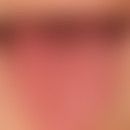DefinitionThis section has been translated automatically.
Incident light microscopic sign of an increased annular pigment accumulation in the area of the basal membrane and the outer root sheath of a hair follicle.
General informationThis section has been translated automatically.
- Reflected light microscopy: The ostium of the hair follicles is surrounded by an inner yellowish-brownish ring, the inner root sheath (corresponds to the str. corneum et granulosum). Peripherally, a wider, yellowish-whitish opaque ring follows, the outer root sheath of vital keratinocytes (corresponds to the str. spinosum). On the outside, the so-called targetoid structure of the follicle ends with a more or less melanin-pigmented seam (Str. basale with basal melanocytes). In malignant melanocytic processes, the peripheral pigment ring can be broken both outwards and inwards by atypical melanocytes. In addition, slate-grey melanophagus accumulations often build up in the interfollicular spaces. While pigment is released transepidermally by the melanocyte nests and can cover the cell agglomerates, melanophages retain the incorporated melanin.
OccurrenceThis section has been translated automatically.
Physiologically in dark-skinned people. Pathological in lentigo maligna and malignant melanoma.
HistologyThis section has been translated automatically.
Increased melanin deposition in the str. basal and suprabasal keratinocytes in dark-skinned people. Naevocytes or atypical melanocytes in the area of the basement membrane follow the hair shaft in depth. Interfollicular melanophages accumulate.






